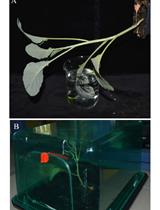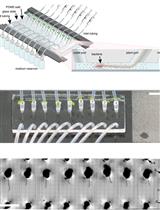- EN - English
- CN - 中文
Quantification of the Composition Dynamics of a Maize Root-associated Simplified Bacterial Community and Evaluation of Its Biological Control Effect
玉米根系相关简化细菌群落组成动力学定量及其生物防治效果评价
发布: 2018年06月20日第8卷第12期 DOI: 10.21769/BioProtoc.2885 浏览次数: 10359
评审: Joëlle SchlapferMeng WuAnonymous reviewer(s)
Abstract
Besides analyzing the composition and dynamics of microbial communities, plant microbiome research aims to understanding the mechanism of plant microbiota assembly and their biological functions. Here, we describe procedures to investigate the role of bacterial interspecies interactions in root microbiome assembly and the beneficial effects of the root microbiota on hosts by using a maize root-associated simplified seven-species (Stenotrophomonas maltophilia, Ochrobactrum pituitosum, Curtobacterium pusillum, Enterobacter cloacae, Chryseobacterium indologenes, Herbaspirillum frisingense and Pseudomonas putida) synthetic bacterial community described in our previous work. Surface-sterilized maize seeds were grown in a gnotobiotic system based on double-tube growth chambers after being soaked in suspensions containing multiple species of bacteria. The dynamics of the composition of the bacterial communities colonized on maize roots were tracked by a culture-dependent method with a selective medium for each of the seven strains. The impact of bacterial interactions on the community assembly was evaluated by monitoring the changes of community structure. The plant-protection effects of the simplified seven-species community were assessed by quantifying (1) the growth of a fungal phytopathogen, Fusarium verticillioides on the surfaces of the seeds and (2) the severity of seedling blight disease the fungus causes, in the presence and absence of the bacterial community. Our protocol will serve as useful guidance for studying plant-microbial community interactions under the laboratory conditions.
Keywords: Maize (玉米)Background
In natural settings, plants are associated with myriad microorganisms of extremely high diversity. These microbes exploit the niches provided by plant hosts and form complex microbial communities (Bulgarelli et al., 2012; Ofek-Lalzar et al., 2014; Cardinale et al., 2015; Edwards et al., 2015; Beckers et al., 2016; de Souza et al., 2016; Niu et al., 2017). Such plant-associated microbiomes are able to affect the development and health of the hosts profoundly (Berendsen et al., 2012). Recently, huge amounts of data describing plant microbiome compositions and their dynamics have been obtained by using advanced DNA sequencing technologies and data analysis methods. Much has been learned about the community structure of plant microbiota (Ofek-Lalzar et al., 2014; Bai et al., 2015; Ritpitakphong et al., 2016). However, due to the great complexity, currently it is nearly impossible to directly define experimentally the mechanisms underlying the dynamics of plant microbiome assembly and their beneficial effects on hosts. The establishment of simplified plant-associated microbial communities under controlled laboratory conditions is an approach to overcome the challenges in analyzing the properties of plant microbiota (Bodenhausen et al., 2014; Bai et al., 2015; Lebeis et al., 2015). Testing of hypotheses by targeted manipulation in gnotobiotic systems with simplified synthetic communities become a lot easier (Vorholt et al., 2017).
Previously, through host-mediated selection, we assembled a greatly simplified, yet representative, synthetic bacterial community consisting of seven strains (Stenotrophomonas maltophilia, Ochrobactrum pituitosum, Curtobacterium pusillum, Enterobacter cloacae, Chryseobacterium indologenes, Herbaspirillum frisingense and Pseudomonas putida) (Niu et al., 2017). We found that the removal of E. cloacae caused dramatic changes of the community composition and that this seven-species community protects maize from colonization by a fungal pathogen, Fusarium verticillioides. These results suggest that this synthetic seven-species community has the potential to serve as a useful system to explore how bacterial interspecies interactions affect root microbiome assembly and to dissect the beneficial effects of the root microbiota on hosts under laboratory conditions (Niu et al., 2017). This protocol has been developed to set up a gnotobiotic system for cultivating maize seedlings colonized by the root-associated simplified communities, to track the dynamics of the composition of the simplified communities and to evaluate the in vivo biological control effects of the seven-species community against F. verticillioides.
Materials and Reagents
- Consumables
- Disposable Petri dishes (VWR, catalog number: 89022-320 )
- Pipette tips (Corning, Axygen®, catalog number: T1005WBCRS ; Biotix, catalog number: M-0200-1RCNS )
- Parafilm (VWR, catalog number: 52858-000)
Manufacturer: Bemis, catalog number: PM996 . - Inoculation loops (Globe Scientific, catalog number: 130118 )
- Centrifuge tubes 2.0 ml (Corning, Axygen®, catalog number: MCT-200-C-S )
- Centrifuge tubes 1.5 ml (VWR, catalog number: 20170-038 )
- Centrifuge tubes 50 ml (Corning, catalog number: 352098 )
- Scalpel blades (Integra LifeSciences, catalog number: 4-110 )
- Glass beads (Propper, catalog number: 03000600 )
- Paper wipers (KCWW, Kimberly-Clark, catalog number: 34155 )
- 96-well plates (Corning, catalog number: 351172 )
- Cell scrapers (VWR, catalog number: 89260-222 )
- Trays (Thermo Fisher Scientific, Nunc, catalog number: 242811 )
- Disposable Petri dishes (VWR, catalog number: 89022-320 )
- Plants
Zea mays cv. Sugar Buns F1 (se+) (Johnny’s Selected Seeds, catalog number: 267 ) - Bacterial strains
Stenotrophomonas maltophilia ZK5342, Ochrobactrum pituitosum ZK5343,
Curtobacterium pusillum ZK5344, Enterobacter cloacae ZK5345,
Chryseobacterium indologenes ZK5346, Herbaspirillum frisingense ZK5347 and
Pseudomonas putida ZK5348 (Niu and Kolter, 2017)
These strains can be requested via e-mail: ben_niu@nefu.edu.cn or roberto_kolter@hms.harvard.edu - Fungal strain
Fusarium verticillioides MRC826 (Hinton and Bacon, 1995) - Chemical reagents
- Ethanol (Decon Labs, catalog number: V1001 )
- Bleach (Janitorial Supplies, Clorox®, catalog number: CLO30966CT )
- BactoTM Tryptic Soy Broth without Dextrose (BD, catalog number: 286220 )
- Soyabean Casein Digest Agar (HiMedia Laboratories, catalog number: GM290-500G )
- Agar (BD, catalog number: 214010 )
- 10x Phosphate buffered saline (PBS) (Lonza, catalog number: 17-517Q )
- Murashige and Skoog Basal Salt Mixture (MS) (Sigma-Aldrich, catalog number: M5524-50L )
- Nalidixic acid (Sigma-Aldrich, catalog number: N8878-5G )
- Colistin (Sigma-Aldrich, catalog number: C4461-100MG )
- Lincomycin (Sigma-Aldrich, catalog number: 62143-1G )
- Chlortetracycline (Sigma-Aldrich, catalog number: C4881-5G )
- Erythromycin (Sigma-Aldrich, catalog number: E5389-1G )
- Vancomycin (Sigma-Aldrich, catalog number: 75423-5VL )
- Sodium chlorite (VWR, catalog number: BDH9286-500G )
- Novobiocin (Sigma-Aldrich, catalog number: N1628-1G )
- Tobramycin (Sigma-Aldrich, catalog number: T4014-100MG )
- Glucose (VWR, catalog number: BDH9230-500G )
- Ethanol (Decon Labs, catalog number: V1001 )
- Media and buffers (see Recipes)
- Tryptone soya agar medium
- 0.1x Tryptone soya agar medium
- Tryptic soy broth medium
- 1x Phosphate buffered saline (PBS)
- ½ Murashige and Skoog (MS) agar medium
- Selective medium for S. maltophilia ZK5342
- Selective medium for O. pituitosum ZK5343
- Selective medium for C. pusillum ZK5344
- Selective medium for E. cloacae ZK5345
- Selective medium for C. indologenes ZK5346
- Selective medium for H. frisingense ZK5347
- Selective medium for P. putida ZK5348
- Potato dextrose agar medium
- Water agar medium
- Tryptone soya agar medium
Equipment
- Forceps
- Pipettes (Gilson, models: P20, P200 and P1000, catalog numbers: F123600 , F123601 and F123602 ; Thermo Fisher Scientific, model: F1-ClipTipTM, catalog numbers: 4661140N and 4661130N )
- Class II biological safety cabinet (Thermo Fisher Scientific, model: HerasafeTM KS9 )
- Centrifuge (Eppendorf, model: 5424 )
- Vortex (Scientific Industries, model: Vortex-Genie 2, catalog number: G560 )
- Spectrophotometer (Beckman Coulter, model: DU 640 )
- Sonicator (Qsonica, model: Q125 , catalog number: Q125-110)
- Balance (Mettler-Toledo International, catalog number: AG135 )
- Hemacytometer (Hausser Scientific, catalog number: 1492 )
- Microscope (ZEISS, model: Axioscop 2 plus )
- Stereoscope (ZEISS, model: Stemi SV 6 )
Software
- RStudio (version 0.99.903)
- QIIME (version 1.6.0)
- PRISM (version 6.0c)
Procedure
文章信息
版权信息
© 2018 The Authors; exclusive licensee Bio-protocol LLC.
如何引用
牛, �. and Kolter, R. (2018). Quantification of the Composition Dynamics of a Maize Root-associated Simplified Bacterial Community and Evaluation of Its Biological Control Effect. Bio-protocol 8(12): e2885. DOI: 10.21769/BioProtoc.2885.
分类
微生物学 > 微生物-宿主相互作用 > 体内实验模型 > 植物
微生物学 > 群落分析 > 悉生培养系统
您对这篇实验方法有问题吗?
在此处发布您的问题,我们将邀请本文作者来回答。同时,我们会将您的问题发布到Bio-protocol Exchange,以便寻求社区成员的帮助。
Share
Bluesky
X
Copy link













